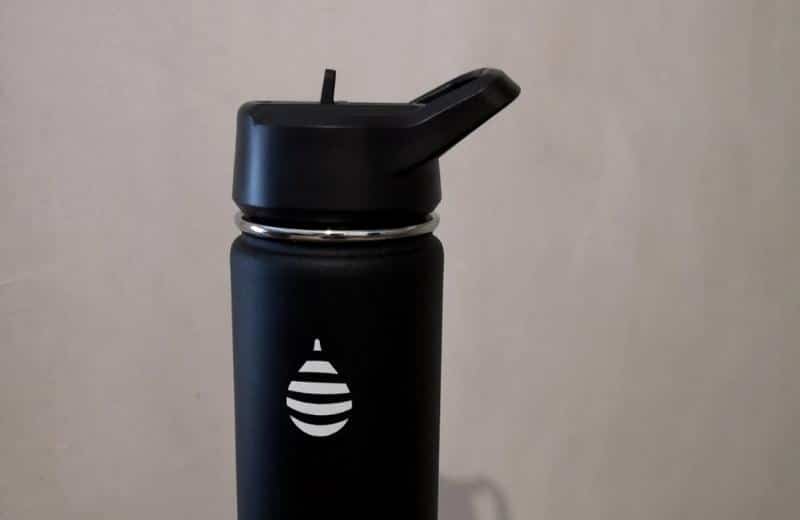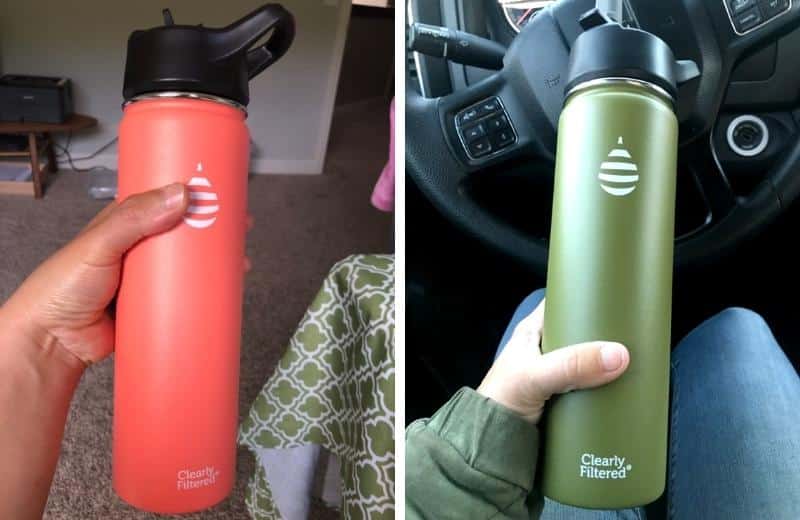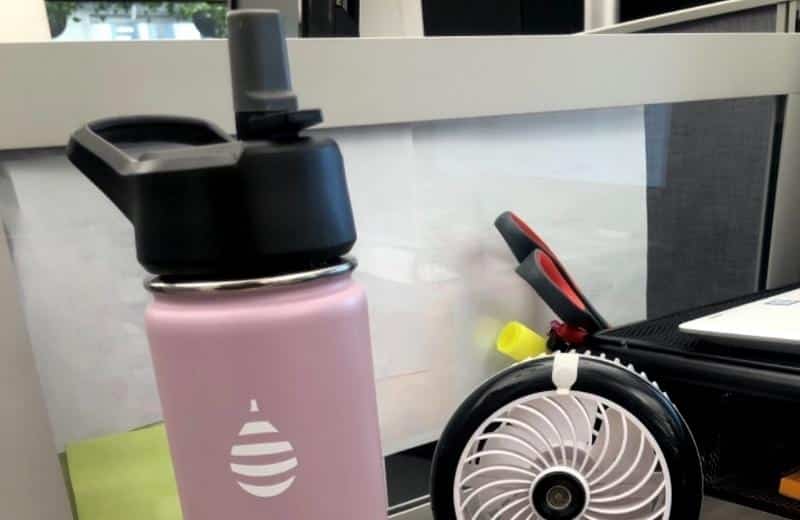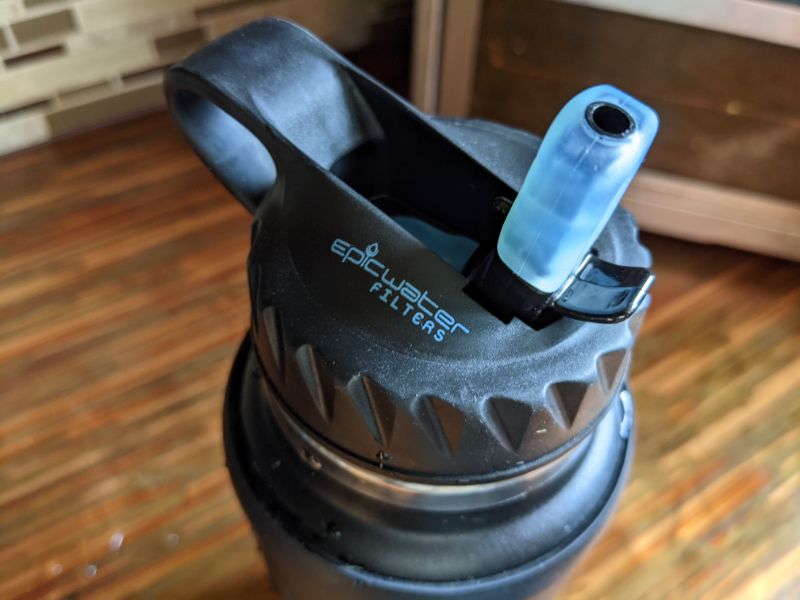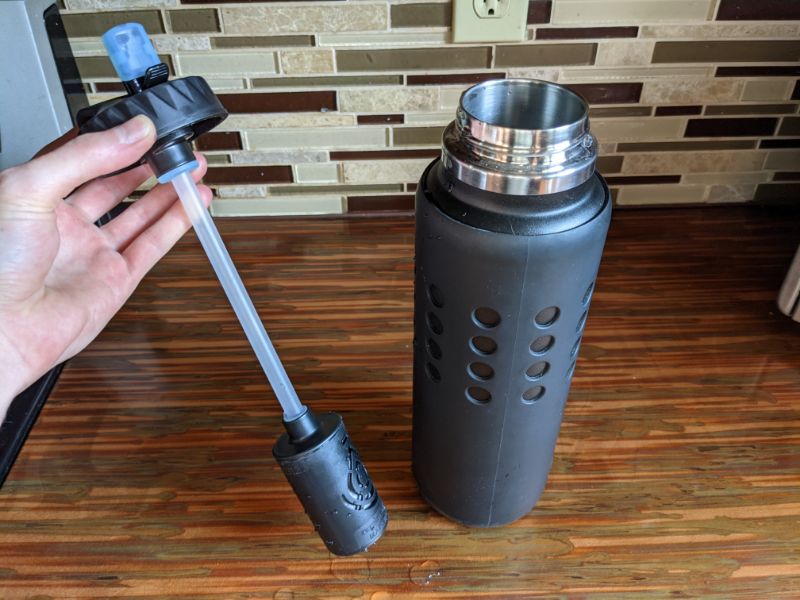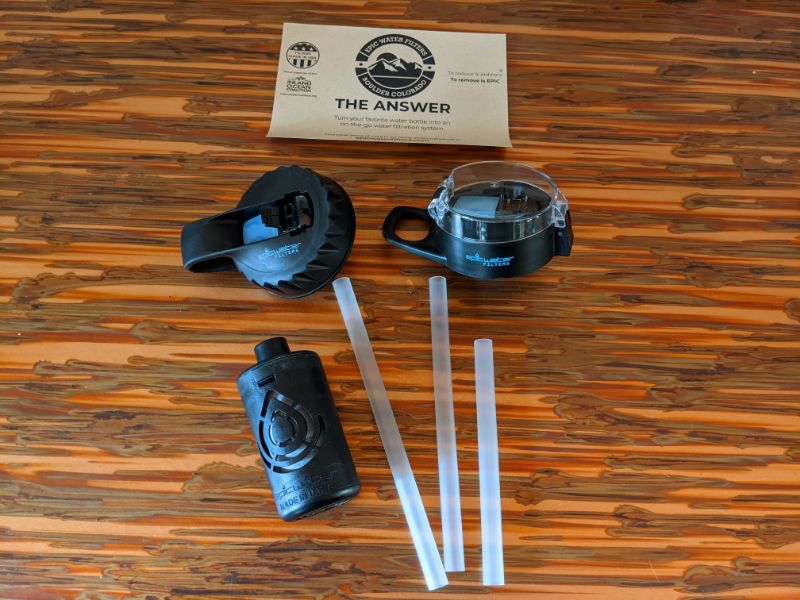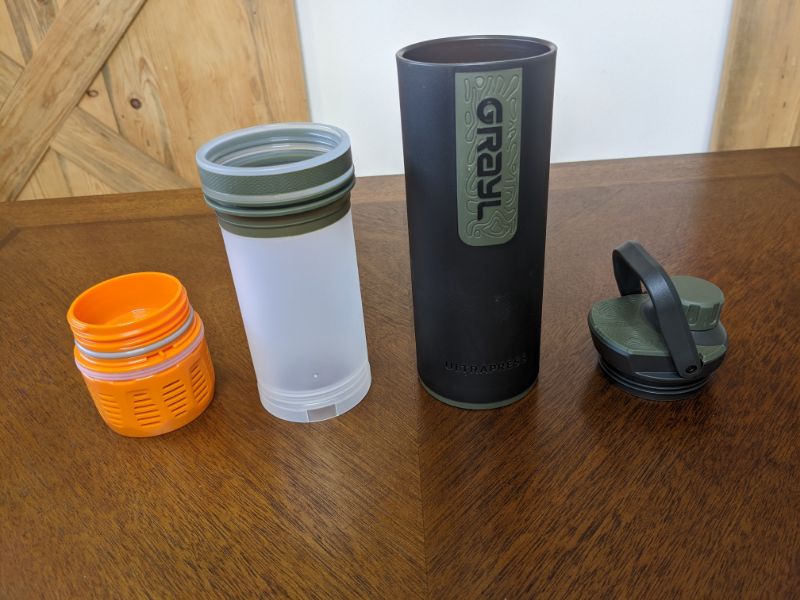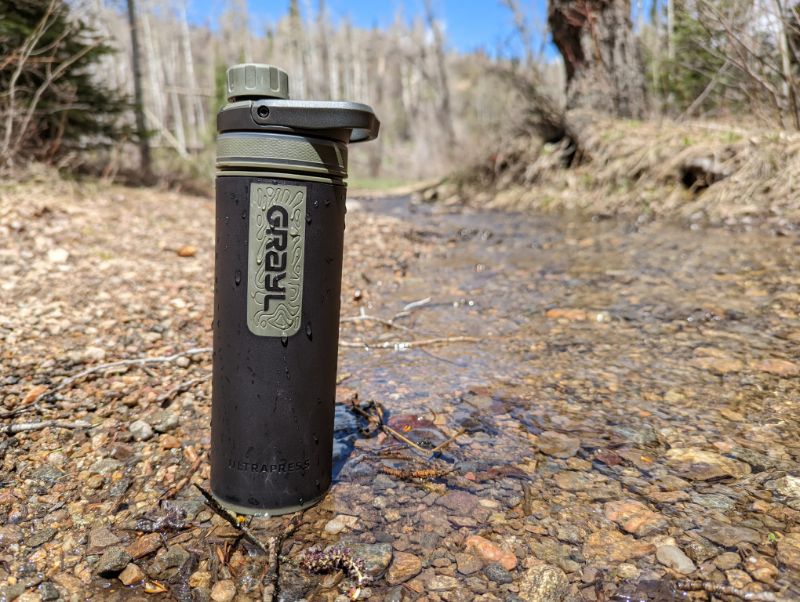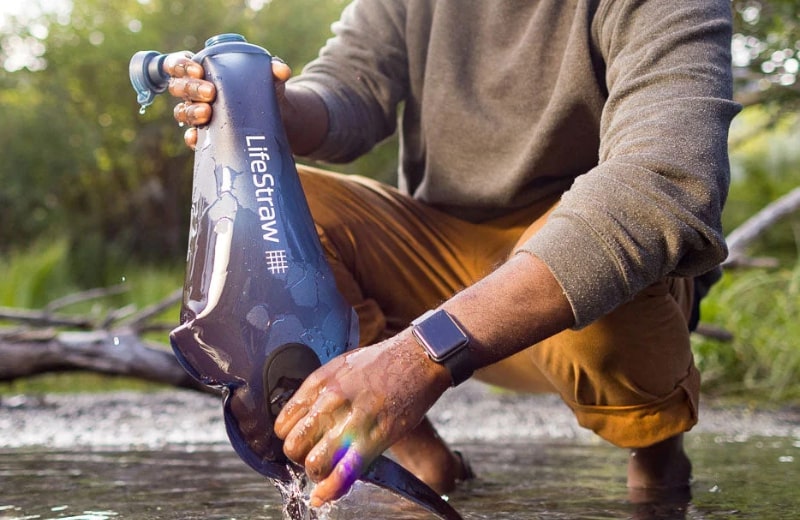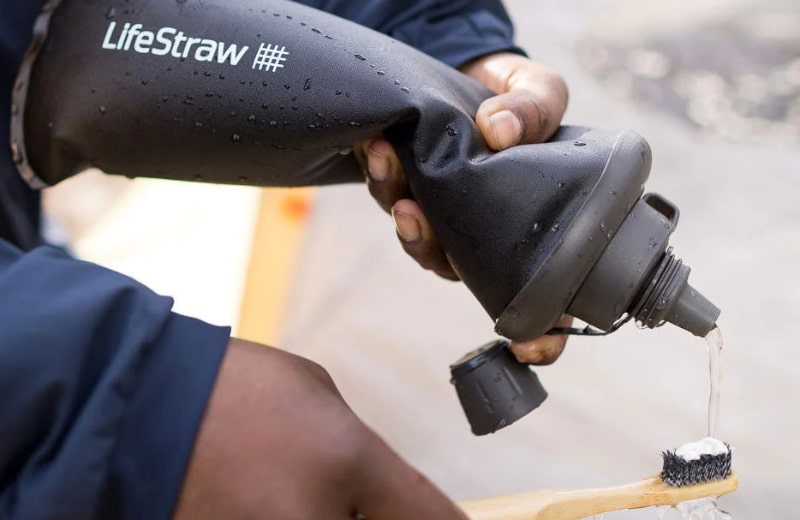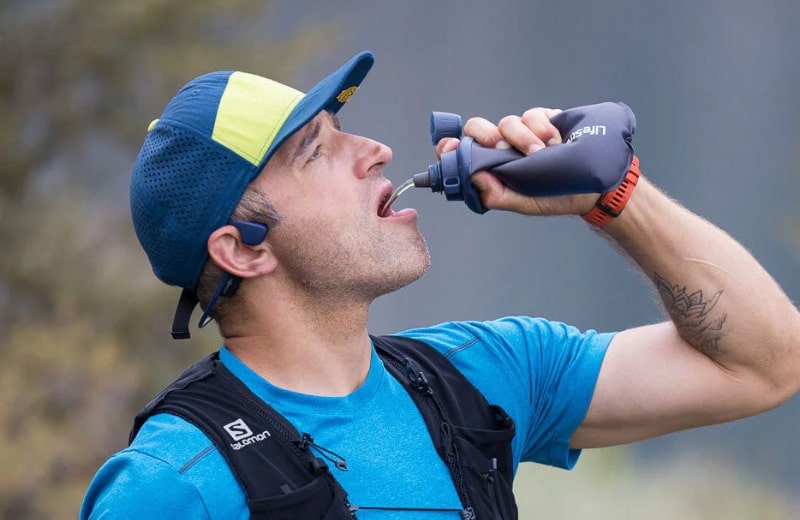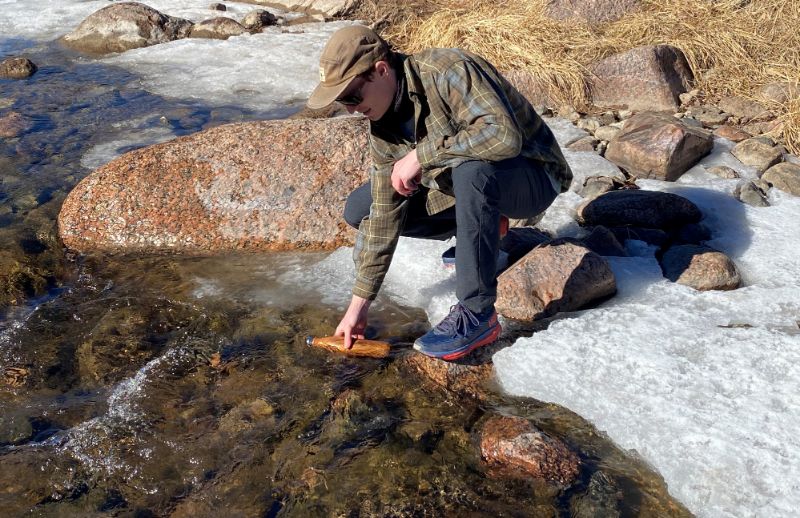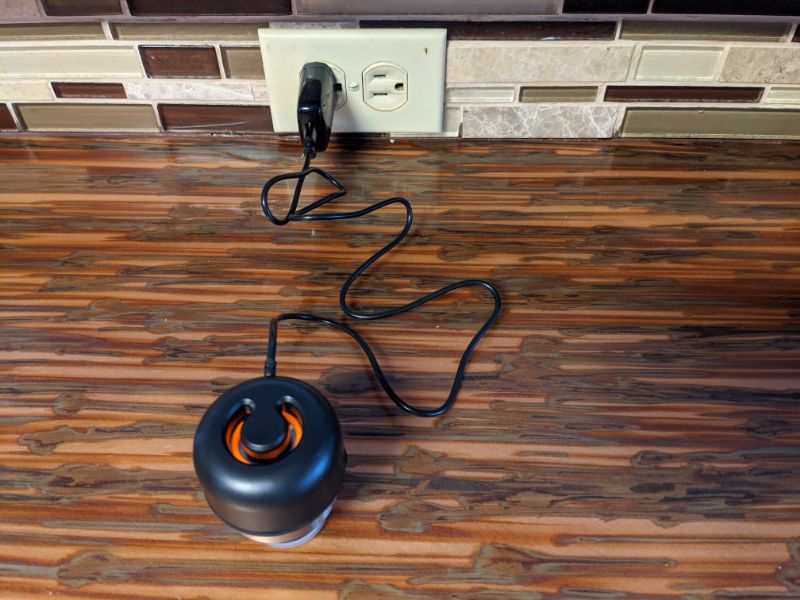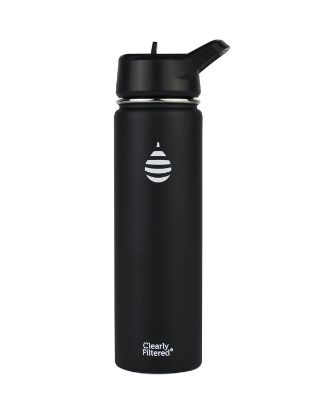
Clearly Filtered Insulated Filtered Water Bottle
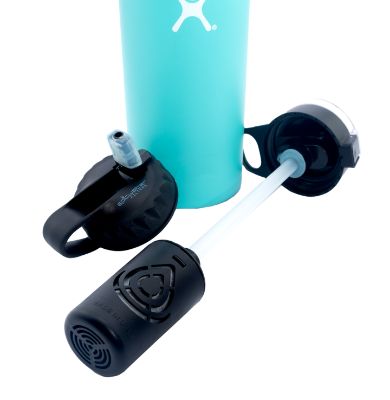
Epic Water Filters The Answer
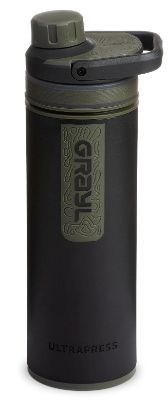
GRAYL UltraPress
We’ve been looking for a portable, personal solution to enjoy filtered water on the go, and filtered water bottles are the best solution we’ve found.
We have more than 10 years of experience testing and reviewing a variety of drinking water filters, and we used our industry expertise to test a range of the most popular filtered water bottles available today.
We ranked the filtered water bottles on this list based on quality, performance capabilities, features, and value for money. Only 5 of the 20+ water bottles we reviewed were shortlisted in this guide.
Table of Contents
🥇 Best Filtered Water Bottle
- Best for City Water: Clearly Filtered Insulated Stainless Steel Filtered Water Bottle
- Most Versatile: Epic Water Filters The Outdoor Answer
- Best for International Travel: GRAYL UltraPress
- Most Portable LifeStraw Peak Series 1L
- Great UV Filter: CrazyCap
📊 Comparison Chart of Filtered Water Bottles
| Bottle | Clearly Filtered Bottle | Epic The Answer | GRAYL UltraPress | Lifestraw Peak Series 1L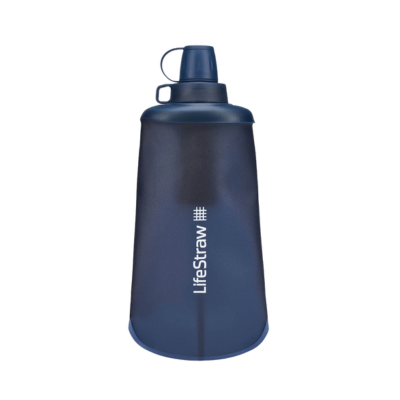 | CrazyCap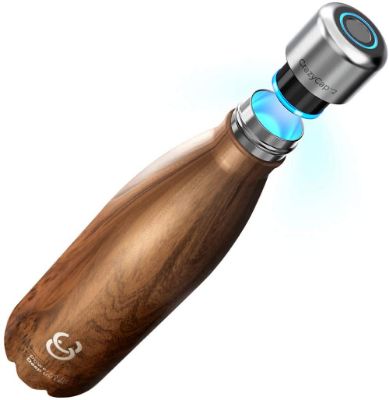 |
|---|---|---|---|---|---|
| Ranking | 1st | 2nd | 3rd | 4th | 5th |
| Ratings | 5/5 | 5/5 | 4.5/5 | 4.5/5 | 4/5 |
| Price | $65+ | $42 | $89.95+ | $43.95 | $99+ |
| Contaminants Reduced | 220+ | 200+ | 8+ | Microplastics, silt, sand, and cloudiness | Biologicals only |
| Pathogen Reduction | – | Bacteria, Viruses, Microbial Cysts | Bacteria, Virus, Cysts | Bacteria and Parasites | Bacteria, Viruses, Cysts |
| Holding Capacity | 12 or 20 oz | Your existing bottle! | 16.9 oz | 1 liter | 17 or 25 oz |
| Filter Life | 25 gallons | 75 gallons or 3-4 months | 40 gallons (~300 presses) | 500 gallons | n/a |
| Material | Insulated stainless steel | Plastic | BPA-free polypropylene | Plastic, Copper, Polycarbonate | Aluminum |
| Process | Carbon + Ion Exchange | Mechanical + Electroadhesion + Ion Exchange | Electroadhesion + Activated Carbon | Membrane microfiltration | UV Light Purification |
| Annual Cost | $25 – $50 | $90 – $120 | $70 – $80 | ~$180 | – |
| Warranty | Lifetime | Lifetime | 10 years | 3 years | Lifetime |
⭐ Best Filtered Water Bottle Reviews 2025

Clearly Filtered Insulated Stainless Steel Filtered Water Bottle
The best filtered water bottle we’ve ever tested is the Clearly Filtered Insulated Stainless Steel Filtered Water Bottle. This filtered water bottle removes 220+ contaminants – that’s more contaminants than any similar filter.
Specs
| Price | $65+ |
| Contaminants Reduced | 220+ |
| Pathogen Reduction | – |
| Holding Capacity | 12 or 20 oz |
| Filter Life | 25 gallons |
| Material | Insulated stainless steel |
| Process | Carbon + Ion Exchange |
| Annual Cost | $25 – $50 |
| Warranty | Lifetime |
We used the Clearly Filtered Water bottle to filter city water in our home in Colorado. We’ve also taken it on our travels and have used it to filter municipal water across the US.
When we got the filter for testing, it cost just under $60. There were a few different colors we could choose from (neutrals like black, white, and grey, as well as bolder shades of blue, green, and pink). The price is pretty average for what you get, especially given that the bottle has a decent 20-ounce capacity (or you can upgrade to the larger 32-ounce bottle for an extra $10). However, the 25-gallon filter lifespan is shorter than some of the other filters we tested. We predicted we’d spend $25–$50 per year on filter replacements.
| Clearly Filtered Insulated Bottles Options | Price |
|---|---|
| 20 oz Bottle | $65 |
| 32 oz Bottle | $75 |
Best For:
Anyone looking for the very best water bottle with a filter for municipal or treated well water supplies, which can remove more contaminants than most other filter bottles.
What We Like:
- Tested to remove more contaminants than any other water bottle filter
- Two bottle sizes to choose from
- Modern, attractive design
- Improves water taste & overall quality
What We Don’t Like:
- Can’t reduce biological contaminants (unlike many filters on this list) so can’t be used to filter natural water sources
- Filter lifespan is shorter than other water bottle filters
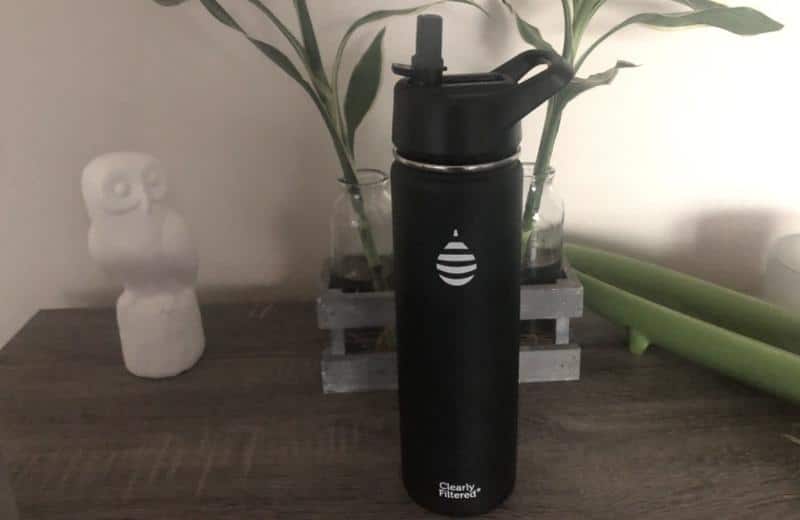
Bottle Straw Filtration
The Clearly Filtered Water Bottle Filter uses a straw filter. The idea is that you sip on the straw, and water from the bottle goes through the filter at the bottom of the straw, then travels up the straw into your mouth.
That means you can only use the bottle with the straw if you want to filter your water. We know some folks don’t like using a straw, so this could be a dealbreaker for you. Plus, as with all straw bottle filters, we did notice some resistance when sipping on the straw. That’s because water had to first travel through the filter media.
Removes 220+ Contaminants & Improves Water Taste
This Clearly Filtered bottle filter removes more than 200 contaminants, according to third-party performance data found on the Clearly Filtered website.
Some of the contaminants removed include:
- Chlorine
- Fluoride
- Lead and mercury
- Pesticides and herbicides
- Pharmaceutical drugs
- Volatile organic compounds
We’ve not been able to find any other water bottle filter that has been third-party tested to remove as many contaminants as the Clearly Filtered Water Bottle Filter. The testing was performed by QFT, a division of IAPMO, so we feel we can trust the results. That said, a big disappointment for us was that the filter doesn’t have any official performance certifications.
The filter itself is made from carbon and ion exchange. Activated carbon uses a process called adsorption and is one of the most popular water filter media because of its proven ability to reduce chlorine, tastes, and odors. Our filtered water tasted clean and pure, with no hint of chlorine, regardless of where in the US we used the bottle.
Easy to Use & Maintain
We went for the smaller 20-ounce bottle, preferring to have something that was easy to store in a smaller bag or backpack between uses. We found that this size was plenty for personal use. But if you want to limit your refills and don’t mind carrying something bigger and heavier, go for the larger bottle.
We noted a few design features of this water bottle that improved our overall experience, including the double-walled stainless steel insulation, which kept our water cold for hours on end. We also liked the silicone mouthpiece, which was comfortable to sip from and easy to clean.
Maintenance was easy – we just cleaned the bottle at the end of every day and replaced the filter when necessary. It supposedly lasts up to 25 gallons, or for 160 full refills. This definitely isn’t the best bottle filter lifespan we’ve seen. But we still think the value for money is pretty great given that the filter has been tested to remove more contaminants than any of its competitors and has a lifetime guarantee.
Read the full review: Clearly Filtered Water Bottles Review

Epic Water Filters The Answer
In our testing, we found that Epic Water Filters The Answer was the most versatile filtered water bottle. The Answer is a pretty ingenious concept: you can screw it onto a range of popular wide-mouth bottles, replacing the existing bottle lid. Plus, it removes more than 200 harmful contaminants, so it’s almost neck-and-neck with the Clearly Filtered water bottle when it comes to quality of water treatment.
Specs
| Price | $42 |
| Contaminants Removed | 200+ |
| Pathogen Removal | Bacteria, Viruses, Microbial Cysts |
| Holding Capacity | Your existing bottle! |
| Filter Life | 75 gallons or 3-4 months |
| Material | Plastic |
| Process | Mechanical + Electroadhesion + Ion Exchange |
| Annual Cost | $90 – $120 |
| Warranty | Lifetime |
We’ve personally used The Answer to filter city water in Steamboat Springs, Denver, and Fort Collins, CO, as well as Ashville, NC, and Houston, TX, and while traveling abroad in Italy and Spain. We’ve also used the new Everywhere filter with untreated mountain stream water in Colorado. Plus, we used the old orange Outdoor filter (which has now been replaced with the Everywhere filter) with tap water in Guatemala and Mexico.
In terms of price, we were impressed. The Answer cost around $55 at the time of our review. We think this is pretty great given that this new updated version of the filter can treat both city water and natural water (originally, Epic offered two separate filters: one for each water type). A two-pack of filter replacements costs around $40. We expect to spend around $80 per year on maintenance.
Best For:
Anyone who likes having lots of options, including the opportunity to use a specially designed filter lid/cartridge with their water bottle of choice.
What We Like:
- Can be used with most wide-mouth bottles, including Hydro Flask, Thermoflask, & Takeya bottles
- Tested to remove 200+ common drinking water contaminants
- Can be used to filter both treated & untreated water
- Improves water taste & overall quality
- Easy to set up and use
What We Don’t Like:
- Not officially performance certified
- Filter life is quite short

Screws Onto Most Wide-Mouth Bottles
The Answer is different from many of the water bottle filters we’ve tested in that it doesn’t come with a bottle.
Epic identified a common complaint that many people have about filtered water bottles: they don’t want to give up their favorite water bottle to use whatever bottle comes with the filter. The Answer solves that problem because it fits most popular wide-mouth bottles, so all you need to replace is the lid. If you don’t have a wide-mouth bottle, Epic sells a couple of bottles that you can buy alongside The Answer, such as the Nalgene bottle.
We really like this about The Answer. Not only does it mean you can use the bottle you prefer aesthetically, but you can also choose the water holding capacity. We used the filter with our 40 oz Hydroflask, and the lid fits seamlessly.
Like the Clearly Filtered water bottle, The Answer uses a straw filter. The filter attaches to the bottom of the straw, and water gets filtered before traveling through the straw to the mouthpiece.
Removes 200+ Contaminants
The Answer removes a similar number of contaminants as the Clearly Filtered bottle filter. It has been third-party tested to remove more than 200 contaminants, including VOCs, heavy metals, pharmaceuticals, and more.
A major advantage of the Everywhere filter used in The Answer is that it combines an activated carbon filter core with an outer nano fiber layer. That means it’s also capable of removing submicron particulates like pathogens, pharmaceuticals, and microplastics. We could confidently use the bottle to filter water even if we weren’t sure whether it was microbiologically safe.
We did a before-and-after taste test with our unfiltered tap water and filtered water from our water bottle. The Everywhere filter was great at adsorbing chlorine and associated chemical tastes, and our filtered water had a clean, pleasant taste.
Filter Activation & Maintenance Notes
We had to activate the filter before we could use it. Epic says it’s best to soak the filter in a bowl of filtered water for 5 minutes. Honestly, this made no sense to us given that we would only have access to filtered water once we’d filtered it with The Answer. The second option is to hold the filter under running cold water from your tap for 1 minute, so we did this instead.
We found the straw easy to sip from, but in our 40-ounce bottle, it was slightly too short, so we were unable to drink the last bit of water in the bottle.
As for maintenance, the filter has a 75-gallon lifespan, and needs to be replaced 3 to 4 times a year when it’s being used every day. That’s around 50 gallons more than the Clearly Filtered Bottle Filter can treat, but it’s still not as good as others we’ve reviewed.
Read the full review: Epic The Answer Review (Updated 2025)

GRAYL UltraPress
Of all the water bottle filters we’ve tested, the GRAYL Ultrapress is the filter we’d feel the most confident using for international travel. We could fill the bottle with any treated or untreated water source, knowing that it would filter nearly all pathogens – including 99% of bacteria, protozoa, and viruses. Most filtered water bottles only remove bacteria and protozoa.
Specs
| Price | $89.95+ |
| Contaminants Removed | 8+ |
| Pathogen Removal | Bacteria, Virus, Cystss |
| Holding Capacity | 16.9 oz |
| Filter Life | 40 gallons (~300 presses) |
| Material | BPA-free polypropylene |
| Process | Electroadhesion + Activated Carbon |
| Annual Cost | $70 – $80 |
| Warranty | 10 years |
We’ve used the Grayl UltraPress while hiking and camping in Colorado, and while traveling in Central America (namely Guatemala and Costa Rica) and Mexico. We predominantly used the bottle to filter untreated river water and water that had been treated, but not to U.S. safety standards.
The UltraPress is one of the more expensive water bottle filters we’ve tested, costing $90 when we got it to review. The good news is that we haven’t seen a price increase in at least a year – it hasn’t gone up since we first reviewed it in October 2022. The filter only lasts 40 gallons, though. Our predicted annual maintenance spend was quite high, at around $70-$80.
| GRAYL UltraPress Options | Price |
|---|---|
| Nature Edition | $89.95 |
| Covert Edition | $89.95 |
| UltraPress Ti | $199.95 |
Best For:
Anyone who prefers the design of a press bottle filter and folks who want to safely filter their water in all locations, including in developing countries.
What We Like:
- Easy press filtration (no resistance from a straw)
- Removes bacteria and viruses
- Quick filtration
- Includes a carbon filter to improve water taste
- Attractive bottle design
What We Don’t Like:
- Short 40-gallon filter life
- Quite big and heavy
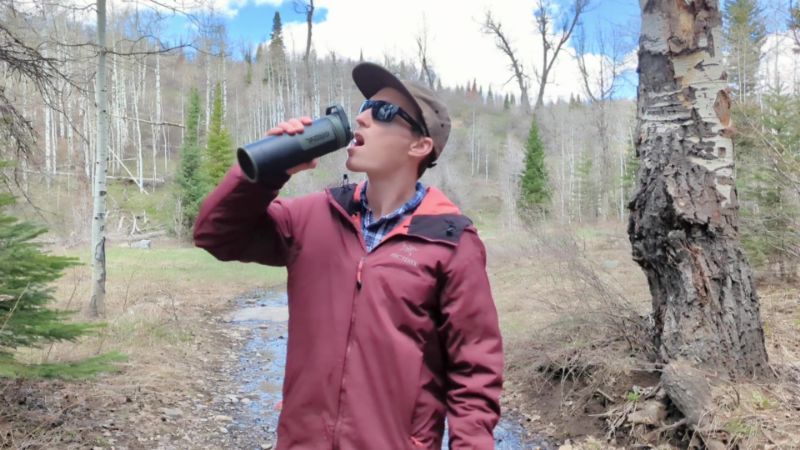
Press Bottle Filtration
The Grayl UltraPress is a BPA-free plastic bottle that holds 16.9 ounces (or 500ml) of water. There are several colors to choose from, including various nature-inspired shades of green, brown, and blue.
Of all the bottle filters we tried, we found this one pretty light (it weighs 12.5 ounces when empty) due to its plastic design. That said, we’d rather the bottle was made of stainless steel; our water warmed up in the UltraPress after just a few hours.
The UltraPress is a press filter, rather than a straw filter, and we personally prefer the press filter design. The idea is that you fill the bottle with dirty water, then press the lid (which has a filter attached to it) onto the bottle until it’s pushed all the way down. Water gets filtered as you press, so it’s instantly ready to drink – no sipping forcefully through a straw.
Filters Metals, Bacteria, & Viruses
The reason we were so keen to test the Grayl UltraPress is that it removes all the most concerning contaminants that we were likely to find in natural, untreated water sources both at home AND overseas.
Some of the contaminants that the filter can remove include benzene, chlorine, lead, arsenic, chromium, sediment, microplastics, viruses, bacteria, and protozoa. The virus removal was the big selling point for us, since it’s possible to find viruses in untreated water supplies in developing countries.
We noticed that our filtered water tasted cleaner, and the carbon element eliminated poor smells associated with chlorine in our city water. It also took away the musty, dirty taste from natural water sources.
The filter’s electroadsorptive activated carbon and ion exchange filter technology has been tested by a third party to meet or exceed NSF Standards 42 and 53 for its ability to remove sediment, pathogens, and chemicals. You can view Grayl’s test report here. Note: the report is for the GeoPress, Grayl’s other water bottle offering, which uses exactly the same water filter as the UltraPress.
Quick, 10-Second Filtration
We found it easy to get started with this water bottle filter. We didn’t have to prime the filter cartridge, so we could simply fill the bottle, press it, and drink filtered water easily from the mouthpiece.
There’s some padding at the top of the bottle, which made pressing the lid more comfortable and reduced the risk of our hands slipping off the top. Still, you do need a bit of core strength to press – we had to use our upper body weight to force the lid down. It was essential to do this on a flat surface to keep the bottle steady. But the whole process took less than 10 seconds, and we preferred it to having to filter water gradually by sipping through a straw.
Again, we don’t think filter lifespan is the best. The filter only cleans up to 40 gallons of water (or up to 300 presses) before it will need to be replaced. According to Grayl, you should replace the filter when the press time exceeds 25 seconds.
Read the full review: Grayl Ultrapress Review

Lifestraw Peak Series 1L
We had the best experience with the Lifestraw Peak Series as the most reliable and practical filtered water bottle. We think it’s better designed for portability and packing light than any other bottle we tested. This collapsible bottle uses Lifestraw’s reliable hollow fiber membrane filter technology to remove bacteria, parasites, silt, sand, and turbidity, and has a really decent 500-gallon filter lifespan.
Specs
| Price | $43.95 |
| Contaminants Removed | Microplastics, silt, sand, and cloudiness |
| Pathogen Removal | Bacteria and Parasites |
| Holding Capacity | 1 liter |
| Filter Life | 500 gallons |
| Material | Plastic, Copper, Polycarbonate |
| Process | Membrane microfiltration |
| Annual Cost | ~$180 |
| Warranty | 3 years |
We used the Lifestraw Peak Series bottle while hiking and backpacking in Colorado. It can be folded up when not in use and is predominantly made from lightweight plastics. We found it was the best filtered water bottle we tried for longer hikes (5+ days) when packing light and conserving backpack space was a priority for us.
There are two bottle sizes: a 650ml bottle and a 1-liter bottle. We went for the larger bottle, which cost around $44. The 500-gallon filter life is better than any other bottle filter we tested – around 10x better in many cases – so for this one, we didn’t have an anticipated annual filter cost.
| LifeStraw Go Options | Price |
|---|---|
| BPA-Free 22 oz | $44.95 |
| 2 Pack- BPA-Free 22 oz | $75.95 |
| BPA-Free 1L | $49.95 |
| 2 Pack- BPA-Free 1L | $84.95 |
| Stainless Steel 18 oz | $49.95 |
| Stainless Steel 24 oz | $59.95 |
| Stainless Steel 1L | $64.95 |
Best For:
Folks looking for a portable, space-saving alternative to a solid water bottle, which can be easily folded to reduce its footprint and reliably removes microorganisms.
What We Like:
- Collapsible and can be folded up when not in use
- Long filter lifespan
- Targets microorganisms and suspended solids
- Weighs just 4 ounces
- Backwashable to extend filter lifespan
What We Don’t Like:
- Backwashing the filter is a hassle
- It’s difficult to dry out the bottle after every use
Squeeze Bottle Filtration
The LifeStraw Peak Series bottle is a squeeze bottle, which is yet another unique design from the other bottles we tested for this guide. The filter sits on the inside of the bottle cap. It’s a 0.2-micron hollow fiber filter, which meets EPA and NSF P231 drinking water standards for its ability to remove bacteria and parasites, as well as silt, sand, turbidity, and microplastics. View the third-party test results here.
To use the bottle, we tilted it above our heads and squeezed the main bottle body, which sent water through the filter and out of the bottle cap.
An advantage of this design was that we could squeeze water into a separate bottle or container if we wanted, so we had filtered water stored ready to use. That meant we didn’t have to filter it as we sipped from the mouthpiece.
Our personal favorite feature of this LifeStraw bottle is that we could simply fold it up and squash it into our backpack when we weren’t using it to filter water.
Something we were less fond of about the bottle design was that we struggled to dry it out completely between uses. We’d often end up folding it up while it was still damp inside. This made us concerned about bad smells and mold formation over time.
Backflushable Design Benefits & Limitations
We really appreciate the fact that the filter in the LifeStraw Peak Series bottle is backflushable – a feature that no other bottle filter on this list has. It meant we could remove sediment from the filter’s surface and make it easier for water to flow through the filter, extending its lifespan.
Our only issue with backflushing was that it was a hassle. We had to remove the filter from the bottle and attach it to a separate backwash syringe (which comes included with the bottle). We then had to use the syringe to send clean drinking water in the opposite direction back through the filter. This simply wasn’t practical to do while out hiking, but we’d often have no choice but to backwash the filter after every use – especially if we only had turbid water sources nearby.

CrazyCap
The CrazyCap is the best UV water bottle we’ve tested. It uses a powerful 20 mW LED UV light, which is built into the bottle lid, to destroy all pathogens – including bacteria, viruses, and protozoa – in the collected water. We found it super simple to purify water with the bottle: we just tapped the lid a couple of times to activate the UV light.
Specs
| Price | $99+ |
| Contaminants Removed | Biologicals only |
| Pathogen Removal | Bacteria, Virus, Cystss |
| Holding Capacity | 17 or 25 oz |
| Filter Life | n/a (UV light requires no filter replacement) |
| Material | Aluminum |
| Process | UV Light Purification |
| Annual Cost | – |
| Warranty | Lifetime |
We used the Crazy Cap to purify our city water in Colorado. We also used it to river water from the Poudre River near Fort Collins, CO, but because the bottle doesn’t have an activated carbon filter, the purified water still had a bad taste. The bottle has two treatment modes: Normal Mode, which has a 60-second purification time, and Crazy Mode, which has a 120-second sterilization time.
We had two buying options for the Crazy Cap: we could buy it on its own (it fits on cola-style bottles like S’Well, Chilly’s, and Mira bottles) or with a 500ml/17-ounce or 740ml water bottle. We personally got the 500ml bottle too, which cost around $99 overall. So no, this isn’t the cheapest bottle out there, but it costs virtually nothing to maintain because there are no filters to replace.
| CrazyCap Options | Price |
|---|---|
| 17 oz | $99 |
| 25 oz | $119 |
Best For:
People who want a no-maintenance, filter-free water purification solution and primarily want to address pathogens in their water.
What We Like:
- Kills harmful bacteria and viruses
- No physical filter to replace
- Quick and easy to use
- No long-term maintenance costs
- Can use with your own compatible bottle if preferred
What We Don’t Like:
- Doesn’t filter out physical contaminants
- Can’t be used with turbid water
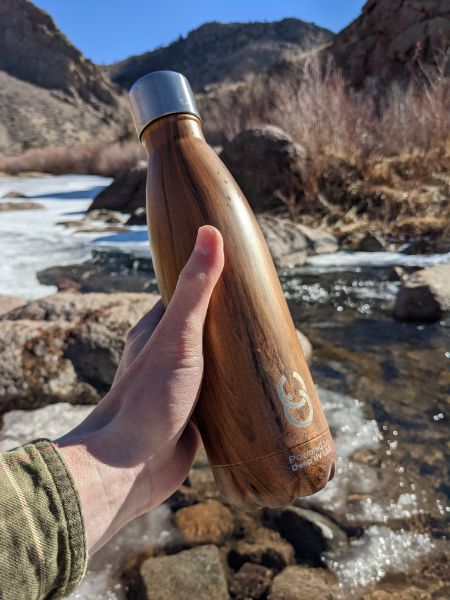
Kills Harmful Microorganisms In Two Taps
We found the Crazy Cap bottle easier to use than most of the other bottles on this list. We simply filled our bottle with a clear water source and tapped the lid to activate the UV light. When filtering natural water sources, we’d tap the lid 5 times to activate Crazy Mode, which delivers a more intense UV dosage and kills 99.99999% of pathogens.
The CrazyCap has been tested by the NSF to Standard 55, for microbiological reduction, so we definitely had the reassurance that this bottle worked as advertised.
We appreciated the lack of a physical filter because we didn’t have the hassle of drinking from a straw filter or pushing a press filter. The Crazy Cap took much less effort to use, although being solely a UV purifier does have its disadvantages.
Our main gripe was that the bottle couldn’t filter suspended particles like sediment, chemical pollutants, or other unwanted impurities out of our water. So, although our water was microbiologically safe, it could still contain other harmful contaminants. Our water didn’t taste any better, either, due to a lack of carbon filtration media.
Plus, while UV purification has been proven to effectively kill all pathogens, it doesn’t work on turbid or murky water, We had to choose clear sources or pre-filter sediment-rich water to ensure it was properly treated by the Crazy Cap.
Easier Long-Term Maintenance
We didn’t have to replace any filters in the Crazy Cap bottle, which was one of the things we personally loved the most about the bottle. We didn’t even have to wash our bottle between uses because the UV light periodically sterilizes the bottle, so there’s no risk of bacteria buildup (which is super common in water bottles).
That said, it does still require maintenance – we had to charge the battery in the lid to keep the UV light working. We were able to check the battery status by tapping the lid once (it glows green, orange, or red depending on how much battery life is left).
Read my full review here: CrazyCap Review (2025)
📚 Methodology: How We Tested The Best Filtered Water Bottles
To produce this guide, we focused specifically on water bottles with an included filtration or purification component that could kill or remove select contaminants.
We considered the following things when ranking, reviewing, and testing our selection of shortlisted filters.
- Water source/contaminants removed – The water sources we planned to filter was one of the most important considerations we made when choosing the best water bottle filters. We knew that some folks would be looking specifically for a bottle that could filter municipal tap water supplies, while others would want to filter both city and untreated water. We tested a variety of bottles, some that removed hundreds of contaminants, and some that offered targeted contaminant removal (for instance, some only remove microorganisms).
- Filtration/purification technology – It was essential to us that the filter bottle systems we tested used effective, proven filtration technology to reliably remove contaminants from water. The most common types of filter technologies in the bottle filters we tested were activated carbon, ion exchange, membrane microfilter technology, and UV purifiers. We devled into the science behind the different filtration methods and learned that there’s no overall best technology – but we found that the most capable filters combined multiple technologies to remove the greatest range of contaminants.
- Filter testing and certifications – The best reassurance of a water filter’s performance is testing to NSF standards or official NSF/ANSI, WQA, or IAPMO certifications. Proof of testing of some form was a non-negotiable for us when shortlisting the best water bottle filters. We also considered filters that met EPA protocols for their filtration method.
- Upfront and ongoing costs – Rather than going for the cheapest water bottle filters we could find, we looked for those that offered the best value for money. The average price of a filter bottle was $40-$100. We anticipated that we’d spend $25-$80 on maintenance (i.e. filter changes) per year. We aimed to review a variety of filter bottles for different budgets and preferences. For instance, the Crazy Cap UV water bottle we reviewed is more expensive at $100 upfront, but costs nothing whatsoever to maintain.
- Ease of setup and use – We knew that folks looking for a water bottle filter wanted something super easy to set up and use, without the hassle of installing a more comprehensive water filtration system. We looked for bottle filters that could be assembled in less than 5 steps for convenience. In terms of ease of use, we reviewed different filter designs, including press filters, squeeze filters, straw filters, and UV filters. Different people have different preferences for filtering their water, and we wanted to offer suggestions for every situation. (In case you were wondering, our personal favorites for ease of use are press bottle filters and UV bottles).
- Durability and design quality – Since water filter bottles are a portable, personal filtration solution, we expected all the bottles we reviewed to be able to withstand a few knocks, bumps, and being slung around in a backpack. Most of the bottles we tested were made from a durable metal like stainless steel, or a strong, BPA-free plastic like polypropylene. We personally preferred stainless steel bottles because they kept our water cold for longer. But we know that some folks will prefer a plastic bottle to avoid weighing down their bags. We paid particular attention to the quality of the filter components, the mouthpiece, and the lid, since in our experience, these are the most likely to crack or break over time.
- Weight and size – There’s no ideal size for a filtered water bottle. You might prefer a bigger bottle to hold more drinking water at a time, or you may want a smaller bottle that takes up less space. Most of the bottle filters we reviewed came in multiple sizes, and some were ultra convenient and could be used with a certain bottle style of your choice. As for weight, we found that most water bottle filters weighed around 4-12 ounces on average. The heavier bottles were made from stainless steel, while the lighter bottles were made from plastic.
- Maintenance considerations – Finally, we considered the maintenance we’d have to commit to if we wanted to use our filtered water bottle for years to come. Most bottle filters have a filter cartridge that needs to be replaced, but lifespan varies (we found that some lasted 25-50 gallons, while some could filter hundreds of gallons before they needed replacing). The backflushable filters we tested lasted longer because backwashing extended their lifespans. We recommend UV bottle filters for folks who want to avoid maintenance as much as possible. These simply need to be charged and don’t have filters to replace.
🤓 About Our Experts
This article was produced by Jennifer Byrd, our water treatment specialist. We’ve shared Jennifer’s author bio below, so you can learn more about her.

